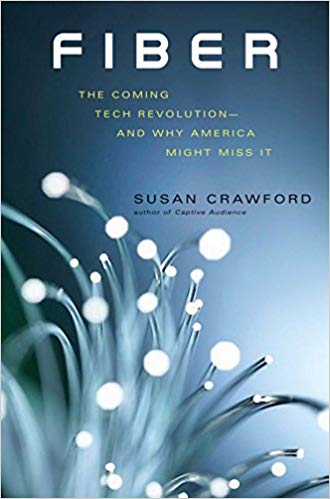You have /5 articles left.
Sign up for a free account or log in.
 Fiber: The Coming Tech Revolution—and Why America Might Miss It by Susan Crawford
Fiber: The Coming Tech Revolution—and Why America Might Miss It by Susan Crawford
Published in December of 2018.
Our digital learning community needs a cause. Some fight that strikes an optimal balance between self-interest and doing the right thing.
Reading Susan Crawford’s deeply reported and passionately argued Fiber, I think the battle for universal fiber broadband might be the fight we need.
How is your home internet? If you happen to live outside rural America, where 4-in-10 households lack access to broadband, you are likely on a cable or DSL connection. A tiny percent of homes, less than 4 percent, have the option of a fiber connection.
Those of us in the US that are lucky enough to have even one broadband option is stuck with internet connections that are vastly more expensive and slower than much of the world. Citizens of South Korea, Singapore, Finland, Sweden, and Japan enjoy universally available gigabit internet connections to their homes for less than $30 a month. How much do you pay for broadband, and at what cost?
As Crawford details, the obstacles for affordable fiber to the home are not technical or financial. Fiber, once laid, is future-proof. Glass does not degrade, and we will not invent a medium that our internet signals can travel that is faster than light. The long service life of fiber means that the long-term costs of maintaining the connections are lower than the copper that carries cable and DSL internet.
The reason that the US lags so far behind in symmetric fast broadband (with gigabit upload and download speeds) is that the US broadband market is dominated by a handful of unregulated companies such Comcast, Verizon, AT&T, and Charter Spectrum. Most US towns and cities have only one, and sometimes two, broadband providers. These local monopolies are under no pressure to upgrade their networks to fiber or to extend broadband out to more sparsely populated areas.
Many towns and cities would like to offer their citizens affordable fiber connections, an effort called municipal fiber. These public efforts to build out municipal fiber networks are bitterly fought by the incumbent telcos in state legislatures, and at the national level. Intense lobbying from Comcast and the other incumbents has resulted in severe restrictions on the abilities of towns and cities to build local fiber networks.
One strategy that the incumbent telcos have followed, as described in Fiber, is to argue 5G wireless networks will provide the broadband services that American’s needs. As Crawford explains, fiber and 5G are not competing but complementary technologies. 5G wireless is very short range and depends on the wireless base stations being connected to fiber.
We should be appalled that a 21st the infrastructure of fiber internet is so poorly developed in our country. Fiber is to this century as electricity was to the last. Just as electrification was the critical infrastructure to create the modern economy of the early 20th century, gigabit internet is the infrastructure that we need today.
How involved is our digital learning community in the fight for universal fiber? Are we lobbying Congress and the FCC? Are we involved at the state level in fighting telco lobbyists? Are we supporting municipal broadband?
Those of us who make our living in digital learning should be the first to recognize the potential of fiber internet to advance online learning. The next generation of immersive learning environments and simulations will require fast connections with low-latency.
Even today, such basic online learning methods such as synchronous class meetings are often difficult to pull off, as not all students have connections fast enough for two-way video. The atrocious state of US broadband will end up being the rate-limiting step for the growth and improvement of online education.
It is time for our digital learning community to put our heads up, and to build some visibility outside of our profession and our campuses. Those of us who work at the intersection of technology and learning should be connecting with local efforts to bring municipal broadband services. We should be throwing whatever weight of our institutions that we can muster behind efforts to extend fiber to our local and regional communities.
Colleges and universities should no longer be content to sit behind our digital walls. The fast networks that we enjoy on our campuses should not stop us from investing in equally fast connections to those who live outside of our gates.
Crawford's book is a call to action. Are we listening?
What are you reading?




